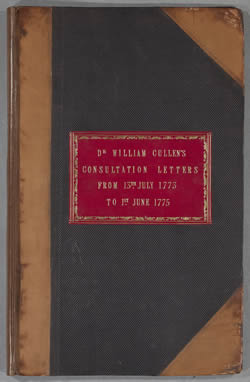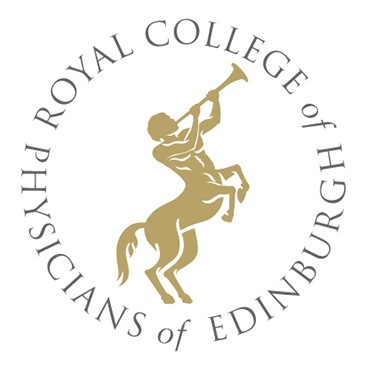
The Consultation Letters of Dr William Cullen (1710-1790) at the Royal College of Physicians of Edinburgh
The Archive
With increasing diligence from the mid 1760s until his death in early February 1790, Cullen retained the bulk of his incoming consultation requests while recording his written replies. The archive of this 'epistolary practice', held by the RCPE, consists of seventeen boxes of loose incoming letters and twenty-one bound volumes of retained copies of Cullen's written responses. Cullen was not the only eighteenth-century physician to undertake 'Consultations' by post, but this unique record is exceptional in terms of scale and the extent to which it provides both sides of the conversation. Many replies include medical recipes (prescriptions).

Front of a re-bound case-book; the survival of the original labels indicates that the case-books originally had "marbled boards".
For the early period Cullen's responses were preserved as transcripts entered into bound case-books eventually labelled 'Dr Cullen's Consultations....'. After 1 April 1781 his retained replies are in the form of copies of the posted originals made on a "pressure" (or "wet-paper") copying machine newly invented by his fellow countryman James Watt. These "pressure" copies were systematically mounted in a series of bulky bound folio volumes. All these volumes were re-bound in the late nineteenth century. For reasons of conservation, as part of this AHRC funded project, they have been carefully dis-bound by professional conservators and, before rebinding to modern conservation standards, the material has been digitally captured.
Apart from one isolated letter to Cullen dated March 1755 when he was still based in Glasgow, the archive relates to Cullen's Edinburgh-based practise though the retention of incoming letters is patchy until the mid-1770s. The earliest extant case-book begins in late January 1764. From the mid-1770s onwards Cullen's archiving becomes far more comprehensive with an integral system of cross referencing and indexing.
Although this material has been explored by a number of medical historians, the sheer physical scale of the archive has inhibited the extensive collation required to trace individual or family case-histories, establish a coherent overview or provide a basis for any reliable statistical analysis. This project to create a publicly accessible on-line digital edition aimed to address these difficulties. It not only rendered this material viewable as high-quality digital images and readable as diplomatic and normalised transcripts, but the texts are also fully searchable. Internal references to ingredients (materia medica), symptoms, conditions, treatments, preparations, actions and body-parts were tagged using XML mark-up. Additional metadata for each item, including all associated dates, persons and places were recorded in the edition's innovative database.

One of the large folios into which the 'Watt Copies' were mounted.
The detailed textual scrutiny necessary to establish our editorial protocols revealed much about the precise status of the case-book transcriptions and how Cullen managed to enact and sustain such an extensive postal practice with multiple enquiries often being answered on a daily basis. These investigations also included work on Cullen's employment of amanuenses and his adoption of the Watt copier. These initial textual findings, coming directly out of the editorial process, have now been published (See ‘Project Outputs’). Other research interests extended beyond these practical matters to the formal and rhetorical nature of the letters, epistolary literacy, the limits of diagnostic communication and the dynamics of intra-physician exchanges.


